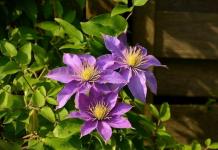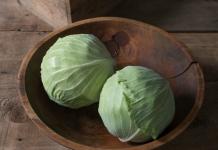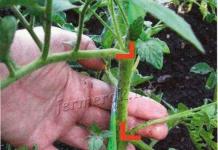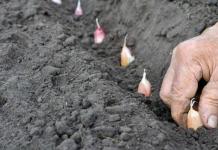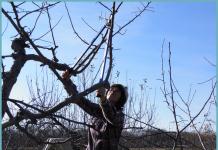Eustoma or Lisianthus is a herbaceous annual or perennial plant. Belongs to the Gorechavkov family. The homeland of this plant is the south of the United States, as well as the territory of Mexico. The most popular lisianthus or eustoma received as a garden ornamental plant, but many growers successfully grow it on window sills in indoor conditions.
This variety of garden flowers has only one species of its kind - Russell's eustoma or Russell's lisianthus. The plant has large beautiful flowers, the variety of shapes and colors of which is amazing.
Eustoma Russell or Lisianthus Russell- has the shape of a small bush. The branches are upright, the leaves are oval with a gray tint. The shape of the flower resembles a large bell. Flowers are both double and non-double. The color is varied (red, yellow, lilac, blue, white, pink). There is a combination of shades and the coloring of the edges in a different color.
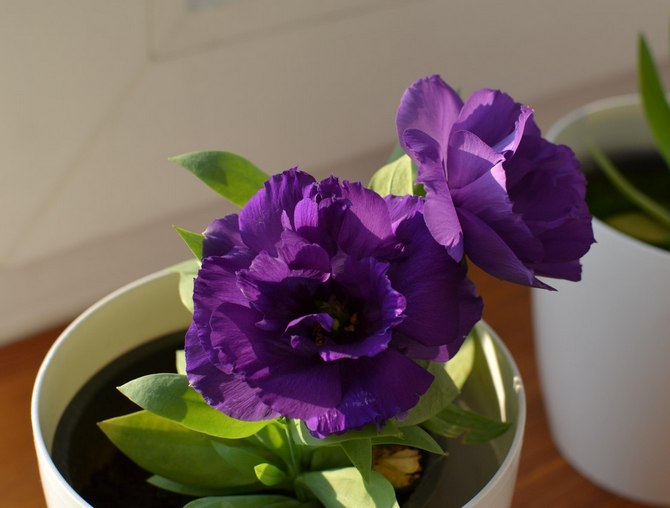
Location and lighting
Lisianthus is picky about having good lighting throughout the day. He will be grateful if direct sunlight falls on his leaves. In spring, when the air warms up well, as well as in summer, it is best to place eustoma on a balcony or loggia with open windows. The plant will delight its owner with abundant flowering even in winter, provided that it receives a sufficient amount of light from the installed phytolamps.
Temperature
In spring and summer, eustoma will feel comfortable at a temperature of 20-25 degrees. In order for lisianthus to be at rest in winter, it needs a temperature of about 12-15 degrees.
Air humidity
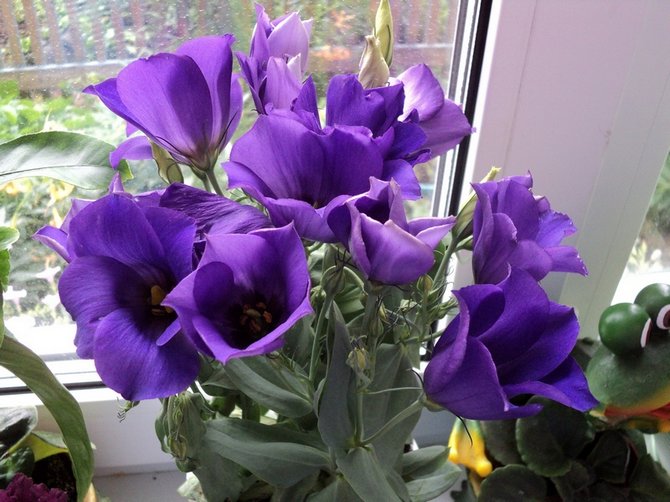
Eustoma feels good in dry air, so additional moisture is not required for the flower. From an excess of moisture on its leaves, the development of fungal diseases can begin.
Watering
In spring and summer, lisianthus blooms and is in the stage of active growth, therefore it is important to prevent the earthen coma from drying out. But too much watering is harmful to the plant. From an excess of moisture, the root system will begin to rot. With the onset of winter cold and a decrease in room temperature, watering lisianthus is reduced.
Top dressing and fertilizers

During active growth, eustoma needs regular application of complex fertilizers to the soil. A universal mineral supplement for flowering is suitable indoor plants... The frequency of its introduction is 2 times a month.
Transfer
In most cases, growers grow lisianthus only as an annual. Transplanting is usually carried out only when growing seeds or propagating by cuttings. The substrate should be nutritious with a pH of 6.5-7.0, a good drainage layer of expanded clay is required - so that water does not stagnate at the bottom of the pot. It is better to take a container for planting (transplanting) eustoma wide, but not deep.
Pruning
Each faded stem is cut off, but not at the very root, but about 2 pairs of leaves are left. With proper care, such a stem will bloom again.

There are two ways to reproduce eustoma: with the help of seeds and by dividing the bush. Seeds must be planted in a container, covered with a thin layer of earth, moistened and covered with glass. Leave in this state at a temperature of about 23-25 degrees. The improvised greenhouse is periodically moistened and ventilated. The first shoots will appear in 10-15 days.
Seedlings must be kept in a bright place with a temperature of 20 degrees. After the plant develops a full pair of leaves, it can be transplanted into a separate pot (1-3 pieces each). In about a year, the first eustoma bloom can be observed. Plants obtained from seeds should overwinter in a cool place with ample light.
Diseases and pests
Lisianthus is affected by thrips, whitefly, tick, gray mold, fusarium or mycosis.
Eustoma or lisianthus - growing and care at home (video)
Lisianthus or Eustoma similar to a rose
Eustoma, lisianthus, "Irish rose" - this is an incomplete list of the names of this beautiful plant, which can really be mistaken for an extraordinary rose. Eustoma is a symbol of fun and joy. From a little-known blue Indian bell, she turned into a "rose of love".

For Mexicans, according to ancient legends, she is the personification of spring. Legend has it that the eyes of the Indians were riveted by a flower that blossomed despite the drought reigning around them, they were struck by the sight of a daring and beautiful flower that looked like a blue bell. This flower reminded people of the untimely extinct daughter of the great leader. Since then, the Indians began to revere the blue bell as the earthly incarnation of a young girl. And its petals gave the tribe the strength to overcome great distances.
Rod Lisianthus ( Lisianthus L.) contains about 60 plant species, from the Gentianaceae family. Lisianthuses are native to warm areas in the southern United States, Mexico, the Caribbean, and northern South America. The plant is popular in gardening as an ornamental plant, and is also used as an indoor plant. Lisianthus as a potted plant became widespread in the 90s of the 20th century. Most often it can be bought in the summer, during the flowering period.
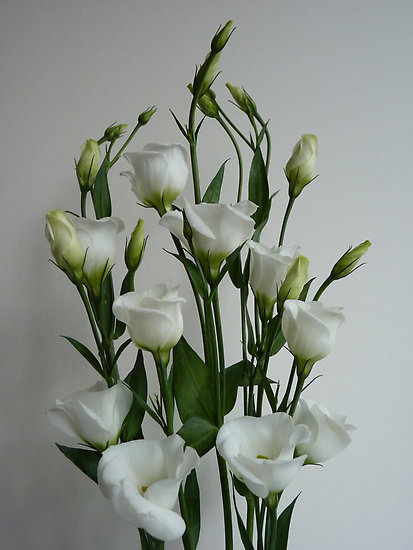
Lisianthus or Eustoma are perennial or annual herbaceous plants of the Gentianaceae family that grow in warm areas in the southern United States, Mexico. The plant is popular in gardening as an ornamental plant, but it can also be used as an indoor plant.
One species is found in culture - Lisianthus russellianus or Eustoma russellianus, although in some sources Eustoma large-flowered ( Eustoma grandiflorum). It has many varieties with different colors and different flower shapes.
Lisianthus Russell (Lisianthus russellianus = Eustoma russellianum), in various sources the main synonym is mentioned Eustoma grandiflorum (Eustoma grandiflorum) .

Lisianthus Russell (Lisianthus russellianus) or Eustoma Russell (Eustoma russellianus) is a shrub with straight branchy stems and oval-shaped grayish leaves. The flowers are large, bell-shaped, depending on the variety, they are double and non-double of various colors (white, blue, lilac, purple, pink, red, yellow, there are also two-color and edged varieties).

Care
Lighting. Brightly lit rooms with some direct sunlight during the day are suitable for placing lisianthus. In summer, it can be open loggias and balconies. If you illuminate with fluorescent lamps for about 16 hours a day, then in autumn and winter you can also achieve flowering.
Temperature. The optimum temperature for lisianthus in the spring-summer period is 20-25 ° C, more high fever do not tolerate well. From autumn, the temperature is reduced, and in winter they arrange a dormant period at a temperature of 12-15 ° C.
Air humidity. Lisianthus does not like high humidity; fungal diseases can appear on the leaves from spraying. Watering
During growth and flowering, lisianthus is watered abundantly, as the top layer of the soil dries up, neither strong waterlogging nor drying out of the earthen coma should be allowed. In winter, with a cool content, watering is carried out carefully.
Fertilizer. During the period of active growth, lisianthus is fed with complex mineral fertilizers for flowering plants 2 times a month.
Transfer. Lisianthuses are most often grown as annuals, so transplanting is only needed when growing from seed or when propagating by dividing the bush.

Sowing of eustoma seeds is recommended to be carried out from February to August, after sowing the eustoma blooms in 6-7 months.Shrub with straight stems, grown indoors as an annual or biennial. For indoor culture, compact varieties are better suited, no more than 45 cm in height.
A loose nutrient substrate with a pH of 6.5-7.0 is suitable for them. The pots are low and wide. At the bottom, it is imperative to provide a good drainage layer of expanded clay.
Pruning. Faded stems of Lisianthus are cut, leaving at least 2 pairs of leaves. With good lighting, new flower stalks can grow from these stems.

Reproduction. Lisianthus is propagated by seed and dividing the bush.
Propagated by seeds in spring, sowing them in small pots and sprinkling with a thin layer of earth. The crops are covered with a transparent film and the air temperature is maintained at 23-25 ° C. Remove the film regularly for airing. Water with a fine spray bottle or through a pallet. Seedlings appear in 10-15 days. The seedlings are kept in a bright place at a temperature of about 20 ° C. When two pairs of true leaves appear, they are planted in separate pots, 1-3 copies each. Young plants grown from seeds should hibernate in the cool and in the light. The first flowering occurs in 10-12 months.
Diseases and pests. Lisianthus can be affected by spider mites, thrips, whiteflies. Of the diseases, lisianthus is susceptible to diseases of gray rot, mycosis, fusarium.
Flowers in eustoma come in a wide variety of colors, from simple to double, and their shape resembles a classic rose.
Eustoma leaves of a bluish shade, elliptical, with a matte waxy texture.
Plants of various cut varieties of Lisianthus reach a height of 50-70 cm. There are low-growing forms up to 30 cm high, which are suitable for potting.
Modern hybrids and varieties of eustoma
Every year more and more seeds of various eustoma appear on the market. Lisianthus seeds are now available not only for professionals, but also for amateur flower growers. Also for sale are eustoma cut with flowers of different colors and flowering plants in pots.
Breeders of the world have bred many varieties and hybrids of eustoma, among which there are spectacular series of varieties with different colors of flowers.
For example:
- non-double variety series "Kyoto" F1 ("White", "Pikot Blue", "Pikot Wine-red", "Pikot Pink");
- non-double variety "Twinkie" F1 (white, yellow, pink, light purple);
- non-double variety "Mermaid" F1 (white, lilac-pink, pale pink, blue, violet);
- "Sapphire" F1 (non-double variety "Blue Chip", double variety "Double White");
- Terry variety series "Echo" F1 (salmon-pink variety "Champagne", "Blue Picoti", "Pink Pikoti", "White", "Yellow", "Lavender", Pink "," With a pink rim "," Blue " );
- Terry mixture "Cinderella" F1.
Growing eustoma in greenhouses and in the garden
Eustoma can be cultivated as a perennial, biennial or annual plant.
In industrial conditions, lisianthus is grown for cutting. In this case, the agrotechnology of eustoma resembles the cultivation of a remontant carnation. The plant is brought to flowering, cut, and then a new generation of peduncles grows from the roots. At home, lisianthus flower stalks are removed after flowering, and the process of plant renewal is the same. In the summer, eustoma can be grown as a garden crop, placing it in partial shade.
In protected ground conditions, eustoma prefers warm and moderately warm content with moist and fresh air. Therefore, it grows well in greenhouses and greenhouses. In the house, eustoma is usually kept in winter gardens and on insulated loggias. However, it is necessary to take into account: in small, poorly ventilated rooms with dry air, Lisianthus does not develop well. Wastes away, and then, as a rule, dies.
For eustoma, western or eastern placement is preferable. Plants need bright, diffused lighting. Lisianthus responds well to supplementary lighting with a combination of "Flora" fluorescent lamps and the usual domestic "LD". At rest, the eustoma tolerates a lack of light. But during the growth period, with a lack of light, the stems pamper, which affects the number of buds laid, reducing the productivity of the plant. Some of the subsequent buds may not open and dry out.
During the period of active growth and flowering, the most optimal temperature for the content of eustoma is 20-25 degrees. In winter, lisianthus must be kept cool (10-15 degrees).
When growing eustoma, do not use large crockery. A drainage layer must be placed on the bottom of the pot.
The soil for lisianthus should be light, peaty, with the addition of pieces of charcoal. From purchased substrates, ready-made soil for Saintpaulias is suitable.
The most difficult and responsible thing in caring for eustoma is to establish the correct irrigation regime. The substrate should be constantly moist, but waterlogging should not be allowed. Here you need to be guided by the drying of the topsoil. Watering the eustoma is done only on top of the pot.
During the period of active growth of lisianthus, developing plants are watered more abundantly, and in winter watering should be careful.
Eustoma needs regular nutrients for good flowering. Top dressing lisianthus complete mineral fertilizer carried out weekly during the growth period, but at a lower concentration than indicated in the instructions.
Growing eustoma for plant lovers in the absence of skills is often difficult. Especially inexperienced growers do not always manage to lead the plant through a dormant period and then get a new crop of flowers. In this case, you must have a supply of your own Lisianthus seeds.

Reproduction of eustoma by seeds
Eustoma is easily pollinated and gives capsules with many small seeds with high germination capacity.
Lisianthus seeds are sown on a sterile substrate, superficially, under film or glass. The temperature during seed germination should not exceed 25 degrees.
Eustoma shoots appear in 10-12 days, at first they develop slowly. The daytime temperature of the crops should be about 22-25 degrees, and the nighttime 20-21 degrees. As the seedlings grow, eustoma seedlings need to be gradually adapted to film-free maintenance.

Lisianthus picking is done 6-8 weeks after sowing. When the seedlings grow up to 1.5-2 cm, I dive them in bunches (3-5 pieces each) into seedling pots with a diameter of 6-7 cm. After the dive, the sprouts must be shaded, the temperature is maintained at 18 degrees. Then I transplant the grown young plants by transferring, without disturbing the earthen coma, into pots with a diameter of 10-11 cm. growing as an annual plant, they do not need more transplants.
It must be borne in mind that eustoma has a small fibrous root system, which is very vulnerable. Therefore, transplant plants with care.
There are not entirely correct recommendations for the reproduction of eustoma by dividing the bush - this, as a rule, ends in failure. Since lisianthus does not tolerate a violation of the root system, all the resulting cuttings may die. Cut off cuttings of eustoma do not take root either. Therefore, the main and most reliable way reproduction of this flowering plant is seed.

Sowing dates of Lisianthus and flowering plants
Eustoma bloom, depending on the characteristics of the hybrid used, as well as on the growing conditions, occurs approximately 15-20 weeks after germination. Therefore, amateur flower growers planning to plant Lisianthus seedlings in the garden begin sowing this plant in winter.
With the industrial cultivation of eustoma, crops are sown at different times, they are possible all year round. For example, to obtain a cut of Lisianthus in May, sowing seeds is carried out in August of the previous year, and to start flowering in August, seeds are sown in April.
Homeland of the unusual garden flower lisianthus are Mexico and North America. This spectacular perennial plant belongs to the family of bitters. In its homeland, for a long time, it is highly valued for its medicinal properties... In Mexico, lisianthus (or eustoma) is often used in various kinds of religious rituals and festivals. In our country, this culture is grown in suburban areas mainly only as decorative.
general description
Until recently, this plant was considered not very suitable for making bouquets, and therefore it was not grown industrially. The fact is that wild Lisianthus has a very short stem and does not look very attractive in flower arrangements. However, since the bells themselves are very beautiful in this plant, it ultimately attracted the interest of breeder biologists. As a result, many tall varieties of eustoma (up to 70 cm) were bred. Today, lisianthus is quite common, including in our country, a garden ornamental plant.
growing from seeds by seedling method
The eustoma plant is southern, and therefore thermophilic. Lisianthus is grown by domestic gardeners mainly from seeds, by seedlings. The best time for planting in boxes is the end of February - beginning of March. The soil for seedlings is prepared slightly acidic or neutral, fertile. Ready-made commercial soil intended for indoor violets is very good for these plants. In order to make it a little more crumbly, you need to add a little sand to it.
How to plant?
Before filling the boxes, the eustoma soil must be steamed. The fact is that this plant is not too resistant to all sorts of bacterial and fungal diseases. The seeds of lisianthus (eustoma) flowers are very small. Therefore, they are usually sold in the form of pills. They are planted in boxes in a superficial way. The soil is preliminarily slightly moistened. After the seeds are spread out on the ground, cover the box with foil or glass. Lisianthus seedlings sprout about 10-12 days after planting. All this time, you need to ensure that the soil in the box does not dry out.

Seedling care
The emerging shoots of eustoma are gradually accustomed to room air, removing the film or glass for an increasingly long time. At first, Lisianthus seedlings are actively growing the root system. At the same time, their green mass develops very slowly. After about 6-8 weeks, young eustomas have 2-3 pairs of true leaves. At this time, they are transplanted into separate pots. It is not recommended to delay the picking of plants. In too large seedlings, overgrown roots can be easily damaged during transplanting.

A pick is usually carried out in small plastic pots (6 cm in diameter). Since the roots of this plant develop very quickly, somewhere in the middle of March, the seedlings are transferred into larger containers (up to 9 cm). In open ground, lisianthus flowers are transferred in early June when the threat of recurrent frosts has passed.
At first, eustoma seedlings are watered exclusively using a spray bottle. Young lisianthuses do not like overdrying very much. Therefore, you need to carefully monitor the soil moisture in boxes and pots. It is best to fertilize plants with a complex product designed for flower seedlings. Such dressing should be applied once every two weeks, reducing the concentration indicated on the package by half.
Where to plant?
In the garden, lisianthus flowers thrive best in slightly shaded, well-sheltered places. These plants love the soil fertile, neutral, drained. It is not worth planting eustomas in the lowlands. In such places, they will certainly begin to develop bacterial diseases.

Very tall varieties of Lisianthus are often planted in the background of yard beds or fences. Low-growing ones look good on alpine slides, as well as in group plantings of bright annuals.
How to plant correctly
It is supposed to plant lisianthus flowers in open ground together with an earthen lump. It is advisable to pre-fertilize the soil in the flower bed with Azophos or Nitrofos. If the land on the site is acidic, it is worth adding ash or dolomite flour to it when digging.
When transferring to flower beds, in no case should the lisianthus flowers be buried. Planting should be done in such a way that the plants are at the same level above the surface of the flower bed as in the pot. The distance between the bushes should be quite large. Eustoma of all varieties grows very lush and at the same time extremely dislikes thickening. If, according to forecasts, a rainy summer is expected, it is advisable to treat the planted lisianthuses with a solution of Fundazol or Fitosporin. The soil under the plants should be covered with a thick layer of peat.
Top dressing in the summer
This ornamental plant consumes quite a lot of nutrients. Therefore, in order to achieve lush bloom, the soil under it needs to be fertilized periodically. Eustoma is fed 3-4 times per season. In this case, infusion of cow or horse manure or compost.
How to water properly?
Adult lisianthus flowers, like young ones, do not tolerate drying out very well. With a lack of moisture, they can even shed their buds. Therefore, eustoma should be watered quite often and abundantly. It is best to do this in the morning or in the evening, otherwise you can burn the leaves of the plant. Between waterings, the soil in the flower bed should dry out a little. Otherwise, the eustoma may develop a black stem. A day after watering, it is advisable to loosen the soil under the lisianthus.

Plant diseases
Various kinds of bacterial and fungal infections, as already mentioned, very often affect lisianthus flowers. Caring for them, therefore, should include all sorts of measures aimed at preventing the development of such diseases.
If these colors are not created good conditions, they can pick up mycosis, fusarium or gray rot. In order to prevent this from happening, certain rules must be followed. When watering, for example, you need to try to make sure that water does not fall on the leaves or stems of the eustomas. The same goes for the manure infusion. This top dressing contains a large number of nitrogen, which can soften the cells of the green parts of plants and make them vulnerable to infections.
If lisianthuses do get sick, they should be treated several times with a solution of soap and copper or 1% boric acid.
Of the pests, eustoma are most often affected by the whitefly and spider mite. In order to rid the flowers of this scourge, they just need to be treated with an infusion of garlic or tobacco.
Lisianthus: According to Legends
As you can see, caring for eustoma is a rather complicated procedure. Most of the time, however, it's worth it. The flowers are really extraordinarily beautiful. At home, in Mexico, Lisianthus are treated with great respect. Varieties with white buds are considered a symbol of femininity, tenderness and love and are used to decorate wedding halls and make bridal bouquets. Lisianthuses with dark flowers, on the contrary, symbolize deep sorrow and sorrow. They decorate burial places, use them in mourning bouquets.

In Russia, lisianthus is generally considered only a wedding flower. It is allowed to give these flowers also on anniversaries or birthdays. Eustoma looks especially impressive in combination with white or red roses.
Lisianthus, or eustoma, can be found very rarely in gardens, as they are most often grown on windowsills.
This flower is also called the "Irish rose", as it resembles her in shape.
Lisianthus is an unpretentious plant, and planting and caring for it will not give you much trouble.
Did you know? The name "lisianthus" comes from the Greek "lysis" and "anthos", that is, "blossoming flower", translated from Latin "lisianthus" means "bitter flower", which is quite justified. Indeed, like many gentian plants, wild lisianthuses contain a large amount of bitterness: gentiopicrin, gencizin, gentiamarin, gentianin, flavonoids, etc.
Description of lisianthus
The genus Eustoma from the gentian family includes three types of flowers. Lisianthus has a different name, namely large-flowered eustoma and Roussel's eustoma.
 Eustoma can be tall and miniature. Tall ones reach up to 1 m in length, and miniature ones - only up to 30 cm. On a thin peduncle there are multiple flowers that open in turn, forming a whole bouquet. Flowers are double, semi-double and densely double, but this depends on the variety.
Eustoma can be tall and miniature. Tall ones reach up to 1 m in length, and miniature ones - only up to 30 cm. On a thin peduncle there are multiple flowers that open in turn, forming a whole bouquet. Flowers are double, semi-double and densely double, but this depends on the variety.
Terry varieties look like roses or carnations. Other varieties have simple flowers that look like tulips, poppies or bells. Some varieties have spiral petals.
Eustoma flowers can be of different colors, ranging from white to red. There are also two-colored lisianthus.
These flowers were brought to Europe from North America... Richard Anthony Salisbury is considered the discoverer of this beautiful plant. The plant is currently popular in America, New Zealand, Australia, and Mexico.
Growing lisianthus from seed through seedlings
Lisianthus can be grown at home, and the process is quite simple if you do everything competently and clearly. In the following sections, you will learn how to grow eustoma from seeds at home and what rules to follow.
When to sow seedlings
 Seedlings can be sown at different times. For example, if you grow eustoma in order to later plant it in your garden, then planting seedlings should be in February or March. After that, you will be able to observe its flowering in July-August. If you want to decorate your apartment with Lisianthus in winter, it is best to plant the plant from July to September.
Seedlings can be sown at different times. For example, if you grow eustoma in order to later plant it in your garden, then planting seedlings should be in February or March. After that, you will be able to observe its flowering in July-August. If you want to decorate your apartment with Lisianthus in winter, it is best to plant the plant from July to September.
Did you know? Irish, Japanese, French, mountain rose - these are all the names of Lisianthus in different countries.
Soil for growing seedlings
Since Lisianthus seeds are small, it is better to buy planting material in the form of granules. This will simplify planting and provide the first feeding of the eustoma, as it consists of nutritious fertilizers and materials.
The soil mixture should be with the addition of peat and sand, with a low level of nitrogen, pH is 6.0. You can buy this mixture at a flower shop or make your own.
How to sow seeds
A small container should be filled with a moist prepared substrate and then sprinkled with seeds. After that, the container should be covered with foil or glass and placed in a warm and bright place. Seeds should be sprayed as needed. Within three weeks you will be able to see the first shoots.
You can also use peat tablets for sowing. They should be of medium size and 4 cm in diameter.
 The small container in which you will put the peat tablets must be rinsed in a pink solution of potassium permanganate. Then, after the peat tablets are placed in the container, a little water should be poured into it. Water is added until the tablets are completely swollen. Excess water must be drained.
The small container in which you will put the peat tablets must be rinsed in a pink solution of potassium permanganate. Then, after the peat tablets are placed in the container, a little water should be poured into it. Water is added until the tablets are completely swollen. Excess water must be drained.
Then small indentations should be made in the tablets with your finger. On them and you need to decompose the seeds - one in each tablet. Do this with a damp toothpick. D To help the seeds germinate through the shell, gently break it with a toothpick when wet. After that, the container must be covered with a lid or foil.
What to create conditions for seed germination
Place the container with seeds under a fluorescent lamp. It should be turned on for 12 hours every day. The temperature should not be higher than +25 ° С, and at night - not lower than +20 ° С. In two weeks you will see the first shoots.
Lisianthus seedling care
Seedlings can be watered with a light stream of water along the edge of the container once a day. Seedlings do not need frequent watering, as they are covered with plastic wrap, which retains moisture.
 But the plants need to be ventilated often so that condensation does not form on the container and film. This should be done once a week or more. You can also harden the plants by airing. It is better to do this during the day and shoot the film for a short time, each time increasing the time intervals.
But the plants need to be ventilated often so that condensation does not form on the container and film. This should be done once a week or more. You can also harden the plants by airing. It is better to do this during the day and shoot the film for a short time, each time increasing the time intervals.
If you decide to grow eustoma for home decoration, the pots should be placed in a shaded, cool place and left there until they are 10 cm tall. Seedlings should be watered regularly.
After that, the flower must be transplanted into a pot with a diameter of 15 cm and placed on a warm windowsill with diffused sunlight.
If you decide to grow lisianthus in order to later plant it in open ground, you need to wait 3 months after planting. When the seedlings get stronger and reach 15 cm in height, you can transplant the plants to the flower bed.
It is not necessary to spray the seedlings, as this leads to diseases of the young leaves. During active growth, lisianthus should be fertilized with liquid complex fertilizers(15 ml per 10 l of water).
Dive seedlings
8 weeks after sowing, the plants must be dived. This should be done very carefully, since the root system of Lisianthus is very delicate.

Important! When transplanting, the earthen lump must not be disturbed.
The sprouts should be dived into special containers for seedlings. They need to be shaded, but the temperature should not be lower than 18 ° C.
Matured plants are transplanted into pots with a diameter of 15 cm, as the roots of the plant become larger and they need more space.
Planting Lisianthus seedlings in open ground
After you have dived the eustoma, it takes a little time for it to grow. Then you can safely start replanting the plant in open ground.
When to plant seedlings in the ground
 It is necessary to plant seedlings in open ground when the threat of even light frosts has passed. Lisianthus usually grows in the tropics, which means that any frost can lead to its death. It is better to do this towards the end of April or in the middle of May. Understanding when you can transplant seedlings in open ground is very simple.
It is necessary to plant seedlings in open ground when the threat of even light frosts has passed. Lisianthus usually grows in the tropics, which means that any frost can lead to its death. It is better to do this towards the end of April or in the middle of May. Understanding when you can transplant seedlings in open ground is very simple.
If there are 8 leaves on it, then the plant is completely ready for planting. It is better to do this in the evening calm time.
Choosing a place on the site
Eustoma is very light-requiring, but it is better to plant seedlings in a place where diffused light will fall on it. The soil for cultivation must be rich nutrients... You also need to take into account the conditions of the native climate of Lisianthus, namely high humidity and warm, mild temperatures.
How to plant seedlings on the site
Before planting lisianthuses in your garden, you need to dig small, pot-sized holes where your eustomas were. Water these holes abundantly.
After that, we begin to deal with the transshipment of an earthen coma, because this is how we will plant eustoma. Cover each flower with half a plastic bottle. This will protect the plant from frost and retain moisture. It is best not to water the plants during this time.
 About 3 weeks after the last frost is gone, the plastic bottle can be removed.
About 3 weeks after the last frost is gone, the plastic bottle can be removed.
The distance when disembarking should be about 30 cm apart.
Features of care for abundant flowering
Eustoma is a wonderful decoration in your garden, especially if it blooms profusely. To do this, you need to properly care for the plant.
Shelter of young plants from frost
Since eustoma is conventionally called perennial plant, it needs to be kept until next year. After transplantation, the adaptation of a plant to a new place takes about a month. If the temperature drops sharply, the eustoma begins to wither and weaken.
It is better to transfer them in late August or early September. Before that, put the pots on a closed loggia, and only then into the room. This allows the plant to get used to the lack of light.
After you cut the bush of the plant, the eustoma will winter in a pot at your home. You do not need to worry, after cutting, the plant will start up new root shoots, and again you can simply plant it on a flower bed near your home.
The main thing is, before transplanting them back into the pot, you should carefully check the roots for possible diseases and pests, sterilize the soil and pot. 
You also need to limit watering while the plant gets used to the new place and conditions. The question arises whether it is necessary to pinch the Lisianthus, and our answer is not necessary. The plant will grow well without your intervention and will develop well and actively.
It is better to plant lisianthus as a one-year-old, since after a couple of years the plant will bloom poorly or become shallow. Sometimes the plant dies altogether, even with the best care.
Did you know? One eustoma plant produces a real bouquet that can be used as a gift at any celebration.
Prevention and protection against pests and diseases
We present you with a list of diseases and pests that can affect your flower, as well as methods of dealing with them:

How to water
It is not difficult to grow eustoma in your country house, but you need to water it correctly, because the most important thing in caring for eustoma is the optimal watering regime. The soil should be constantly moist, but the soil should not be overmoistened. To understand that your plant needs watering, you just need to touch the soil. If it's dry, water it. This should be done with soft water.
During active growth, the eustoma needs to be watered often, and in winter you need to be careful. Watering is done at the root, the main thing is not to get on the leaves. This can lead to fungal infections. Spraying is best avoided for the same reason.
During flowering, lisianthus needs watering, so it should be increased and done more often.
Did you know?Another name for eustoma is "prairie bell": in nature it grows in Mexico, the American states of Texas, Colorado, Nebraska and in the northern part of South America.
When and how to feed
It is imperative to feed the plant if you want to get abundant flowering.
Complex feeding is suitable for Eustoma, especially for the first time - a week after transplanting into open ground. Best of all, the flower perceives water-soluble dressings. 
It is better to do this during the period of active flowering. When the plant is actively growing, you need to feed the plant with complex mineral fertilizers every week, but it is better to do a lower concentration than what is suggested in the instructions.
During the flowering of lisianthus, it is better to replace nitrogen fertilizers with potash and phosphorus fertilizers.
In this article, you could learn all about the eustoma flower, as well as how to grow it at home. Plant a plant in your flower bed and catch the envious glances of your neighbors.
Was this article helpful?
Not really
Lisianthus, an exquisite and unusually beautiful plant, appeared in our country relatively recently. Other names by which the lisianthus flower is known are eustoma, as well as "Irish" or "Japanese rose". Such qualities as a variety of varieties, shades and a long lifespan of Lisianthus were highly appreciated by professional florists. Boutonnieres, flower wreaths and bracelets, a luxurious bridal bouquet made of eustoma - these accessories are at their peak of popularity today.
But amateur gardeners will also love Lisianthus. This article contains tips and tricks for growers planning to start growing lisianthus plants, photos of flowers. How to Grow an Irish Rose? Lisianthus feels good in the garden, and in indoor conditions this original plant can serve as a decoration for the house for many years. What do you need to know for those who decide to grow lisianthus (
Description of Japanese rose
The main advantage of eustoma is its attractive appearance with large, funnel-shaped leaves and flowers that can be velvety or regular. The shade of flowers is found in the most diverse, and their size in large-flowered species reaches 8 cm in diameter. The most common shades are white, lilac, pink, violet, white with a border of all kinds of colors, etc.
When lisianthus flowers are in a half-open state, their significant similarity with rosebuds is visible, which was the reason for the assignment of the second name. And at the moment of full disclosure, the eustoma flower becomes more like poppies. The stems are strong enough and can stretch up to 85 cm in height, starting to branch strongly from the central part. Because of this feature, even one plant can look like a full-fledged bouquet, on which sometimes 3-4 dozen flowers grow!
Each variety of eustoma has peduncles of considerable length, so it is convenient to cut flowers, and, by the way, after that they retain their beautiful appearance in a vase for a very long time.
The decorative qualities of Lisianthus are so highly appreciated by everyone who sees this plant that it quickly became widespread throughout the world. In Holland, where, as you know, floriculture is put on the conveyor, eustoma confidently retains its leadership and is one of the ten most popular cut flowers.
Growing lisianthus
When growing a plant, you should adhere to the following rules.
Accommodation... Lisianthus prefers to grow in a well-ventilated, warm place with bright, diffused lighting. A small amount of direct sunlight can be allowed to enter the plant. It should be borne in mind that lisianthus develops poorly in tight, poorly ventilated rooms, since it loves fresh air very much. When growing indoors, the pots are best placed on east or west facing windows. When placed on southern windows, on sunny days, the plant needs to create a light shade to prevent the appearance sunburn on flowers and leaves. In summer, the plant can be taken out into the open air - in containers on the terrace, balcony, or in protected ground in the garden. Also, lisianthus grows well in greenhouses and greenhouses.
Temperature... In the spring-summer period, it is necessary to maintain a temperature of 20 - 25 ° C, in winter a period of dormancy begins, therefore the most optimal temperature regime at this time - 12 - 15 ° C.

Watering... Water the mountain rose abundantly with soft settled water after the top layer of the soil dries up. It is imperative to water always only on top of the pot, and 10-15 minutes after watering, drain excess water from the pan. Lisianus does not tolerate overflow and acidification of the substrate. It is also not recommended to spray the plant, and when watering it is necessary to ensure that water does not get on the leaves and shoots - excess moisture can cause fungal diseases. In cool weather, it is recommended to limit watering to avoid waterlogging of the soil. In winter, the plant is placed in a cool room and watered very sparingly and carefully.
Top dressing... During the period of flowering and active growth, lisianthus needs regular feeding, which is carried out once a week with a complex mineral fertilizer for flowering plants. For optimal growth conditions, Lisianthus needs calcium and phosphorus the most. When buds appear, it is recommended to add potash to the top dressing.
Priming... A well-drained demineralized soil with a pH of 6.5 - 7.0 is suitable for the plant. Lisianthus is very sensitive to the concentration of salts and the acidity of the environment. As a substrate, you can use a ready-made universal flower soil, or a mixture of turf, compost, leafy soil with peat and sand. The plant should be grown in wide pots with large holes and a thick layer of drainage (perlite, expanded clay) at the bottom ..
Reproduction of eustoma
Eustoma is propagated by seeds. Since the seeds are very small, it is best to purchase them in the form of granules, as granular seeds are much easier to sow. Sowing is best done in mid-March. To do this, you need to prepare sterilized soil and small pots. The seeds are sown on the surface of the soil and, in order not to wash them off during watering, water is poured only into the sump. Crops should be covered with transparent film and the air temperature should be between 23 and 25 ° C during the day and about 18 ° C at night. The film must be regularly lifted for airing. 
Shoots appear in 10 - 15 days. They grow very slowly. Small plants should not be left in direct sunlight for a long time, as they may die. When they have 4 - 6 real leaves, they will need to be cut into separate pots. When 10 days have passed since the transplantation, you can start feeding the plants with liquid complex fertilizers that contain trace elements. If desired, young plants can be planted in open ground as soon as the threat of spring frost has passed. They usually start blooming after a few days.
Sometimes eustoma is grown directly in open ground... For this, seeds are sown on the surface of the soil, keeping the distance between plants in 15 - 20 cm. It is interesting that the air temperature often affects the "behavior" of eustoma. If young plants, when developing from seeds, were warm from 23 to 25 ° C, then they develop as annuals, that is, they begin to bloom in the first year of life. If the air temperature was significantly higher - 29 - 30 ° C, then their flowering period shifts. In the first year of life, they only form a rosette of leaves, and bloom in the second year.
Delicate "rose" will decorate both the house and the garden. It is beautiful as a monoculture, but it can also be used to create various compositions. In its native land, it is considered not only an ornamental, but also a medicinal plant.
Varieties of eustoma

Certain types and varieties of this beautiful plant becomes more from year to year. Not so long ago, seeds were available only to those who were professionally engaged in flower cultivation, but now every amateur florist can purchase them without any difficulty. When buying, it should be borne in mind that all varieties are conventionally divided into two large groups - low and tall. The latter group is intended for growing in gardens, as well as for commercial purposes for cutting. Low-growing varieties are used as indoor crops and will decorate a home windowsill or balcony.
If a tall eustoma is bought for the garden, then preference should be given to annual plants, since biennial varieties require appropriate painstaking care and cultivation in equipped greenhouses.
By their type, flowers are divided into double and simple. The first ones look especially beautiful and impressive, so when choosing, you should take this moment into account. If you look at the shades of the colors themselves that are now available, then you can safely choose any one, since all the color options for lisianthus look simply amazing.
Of the interesting varieties available with us, two series can be distinguished - these are ABC F1 and Echo F1. The first includes Misty Blue, Pink, Blue Rome and Purple. In the second, Deep Blue, Champagne, Rose Picoti, etc. Each of these varieties is distinguished by strong and long shoots that adorn large flowers with an elegant double texture.
Planting eustoma seedlings on the street

It is better to plant eustoma seedlings in the garden in the evening, carefully moving the plant along with the earthy clod into previously prepared and watered holes. The deepening must be done so that after planting the Lisianthus was at the same level that it had in the pots. After finishing planting, you should cover each plant. For these purposes, plastic bottle cuts are well suited, which help to retain heat and moisture, protecting the seedlings from frost. In such a covered form, eustoma grows for about 3 weeks.
The choice of the landing site should be carried out according to the level of illumination. Lisianthus loves to grow in the sun, and its flowers will be a worthy decoration of the garden. Therefore, you can safely choose the sunniest and most noticeable place. There is no need to specially prepare the soil, since the chernozems common in our country are excellent for growing Japanese roses.
Planting in pots for indoor floriculture is usually carried out in early March. To do this, they stock up in advance in pots, the diameter of which is about 8 cm. You can take a larger size, but it has been proven that eustoma likes to grow in a small space. The bottom of the pot is filled with any compound that will provide good drainage. For such purposes, zeolite, expanded clay or even foam can be used.
Plant diseases and pests
Whiteflies, spider mites, and thrips can attack lisianthus. In this case, it is necessary to treat the plant with deltamethrin-based insecticides. If the plant is affected by white mold (Lievellula taurico), it should be treated with triforin and benzimidazole fungicides once a week.

























